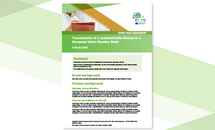Risk assessment: Outbreak of acute respiratory syndrome associated with a novel coronavirus, China: first local transmission in the EU/EEA − third update
On 31 December 2019, a cluster of pneumonia cases of unknown aetiology was reported in Wuhan, Hubei Province, China. On 9 January 2020, China CDC reported a novel coronavirus (2019-nCoV) as the causative agent of this outbreak, which is phylogenetically in the SARS-CoV clade.
Executive Summary
On 31 December 2019, a cluster of pneumonia cases of unknown aetiology was reported in Wuhan, Hubei Province, China. On 9 January 2020, China CDC reported a novel coronavirus (2019-nCoV) as the causative agent of this outbreak, which is phylogenetically in the SARS-CoV clade.
As of 30 January 2020 09:00, more than 7 000 laboratory-confirmed 2019-nCoV cases have been reported worldwide, mainly in China, but also with more than 70 imported cases from other countries around the world. Details on the epidemiological update for 2019-nCoV can be found on ECDC’s website.
So far, one hundred and seventy deaths associated with this virus have been reported. On 20 January, Chinese health authorities confirmed human-to-human transmission outside of Hubei province. Sixteen healthcare workers are reported to have been infected.
On 24 January 2020, the first three cases of 2019-nCoV imported into the EU/EEA were identified in France and one additional case was reported on 29 January 2020. On 28 January, a cluster of four locally-acquired cases, with indirect links to Wuhan, was reported from Germany. On 29 January, Finland reported an imported case from Wuhan.
China CDC assesses the transmissibility of this virus to be sufficient for sustained community transmission without unprecedented control measures. Further cases and deaths in China are expected in the coming days and weeks. Further cases or clusters are also expected among travellers from China, mainly Hubei province. Therefore, health authorities in the EU/EEA Member States should remain vigilant and strengthen their capacity to respond to such an event.
There are considerable uncertainties in assessing the risk of this event, due to lack of detailed epidemiological analyses.
On the basis of the information currently available, ECDC considers that:
- the potential impact of 2019-nCoV outbreaks is high;
- the likelihood of infection for EU/EEA citizens residing in or visiting Hubei province is estimated to be high;
- the likelihood of infection for EU/EEA citizens in other Chinese provinces is moderate and will increase;
- there is a moderate-to-high likelihood of additional imported cases in the EU/EEA;
- the likelihood of observing further limited human-to-human transmission within the EU/EEA is estimated as very low to low if cases are detected early and appropriate infection prevention and control (IPC) practices are implemented, particularly in healthcare settings in EU/EEA countries;
- assuming that cases in the EU/EEA are detected in a timely manner and that rigorous IPC measures are applied, the likelihood of sustained human-to-human transmission within the EU/EEA is currently very low to low;
- the late detection of an imported case in an EU/EEA country without the application of appropriate infection prevention and control measures would result in the high likelihood of human-to-human transmission, therefore in such a scenario the risk of secondary transmission in the community setting is estimated to be high.
What is new in this update
- Increasing number of cases and deaths, in particular in China.
- First cluster of autochthonous transmission in EU/EEA.
- China CDC estimates for transmissibility.
- Entry screening guidance.
- Contact tracing guidance.
- Findings from studies on initial cases.
- Recommendation for reviewing pandemic preparedness plans in EU/EEA.
Download
Read more
Disease page
COVID-19
See all information on COVID-19, situation updates, risk assessments, questions and answers, latest evidence, surveillance and laboratory guidance and how to protect yourself and others.






